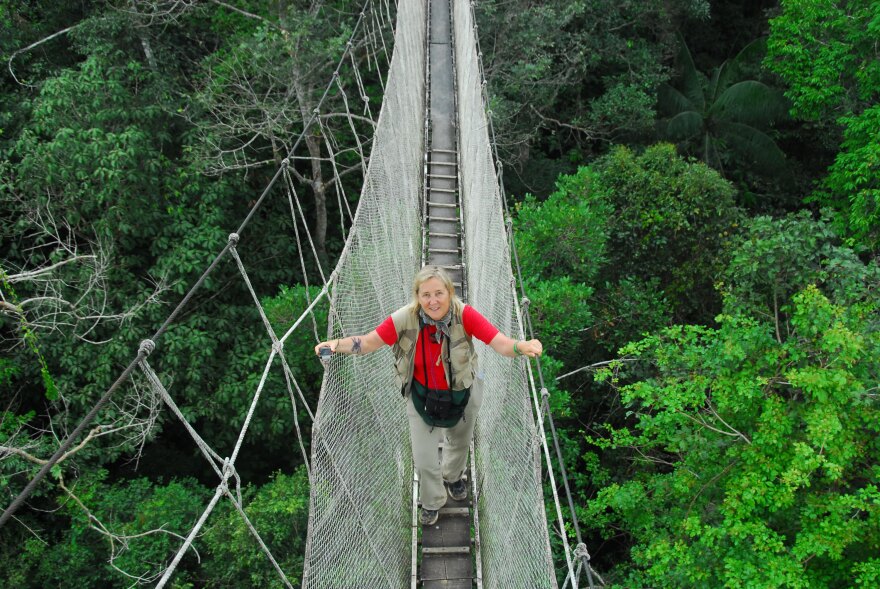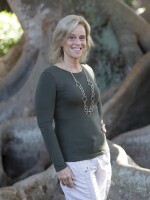A pioneer of forest canopy research, Lowman has spent four decades studying the vast biodiversity in the top of trees and working to conserve the world’s most important forest canopies.
WUSF's Cathy Carter recently spoke with Lowman about her new book, tree canopy science, and the relationship between deforestation and climate change.
Meg, you spent your lifetime studying trees and sustainable ecosystems. Can you tell us a little bit more about your passion and also how you would like younger people to embrace ecology and conservation?
I think I started my career in trees at about age three. I was one of those really geeky kids that collected birds’ nests when they fell to the ground and collected snake skins and dried wild flowers and all kinds of kooky things. But I always felt ostracized as a nature kid in my generation because I think it wasn't very cool to do that. While girls were getting manicures and curling their hair, I was birdwatching or something really crazy. And so, in some ways to give back, I always hope that my books and my advice would mentor young girls, as well as boys. I'm the proud mother of two sons. So, I really feel the opportunity for both sexes exists. We just need to explore because there's lots left to do.
Your new book is called The Arbornaut, and its subtitle is Life Discovering the Eighth Continent in the Trees Above Us. What is the eighth continent?
Well, going up a tree allows you to see some 50% of biodiversity on the earth. We probably know less than 10% of that and we certainly haven't studied it. So, all of a sudden that conjures up exploration like Columbus or perhaps going to Antarctica. So, we've over the years, we referred to it as the eighth continent, meaning it's unknown. It's mysterious, and it's waiting to be discovered.

Well, you've come to be known as ‘Canopy Meg' for your work studying the world's tree tops, and you were the lead figure in creating the canopy walkway at Myakka River State Park. So, tell us a little bit more about canopies and tree top science.
First of all, the word Arbornaut is kind of fun. Astronauts explore outer space of course, and a couple of us decided we should be Arbornauts because we explore the tops of trees. It's much closer to home, but it's still just as unknown. The canopy itself is defined as this area of foliage in any type of vegetation, a corn plant actually has a canopy and so does a little tiny wildflower, and in forests, it can span anywhere from 10 feet to 300 feet. So, it's the big green stuff above your head.
So, let's talk about how that green stuff relates to climate change. In a report released this week by the United Nations, nearly 200 scientists weighed in on the perils of climate change. Can you tell us a little bit about the relationship between deforestation and climate change?
Sure, and unfortunately, during my lifetime, about half of the world's mature forests have disappeared with humans as the main cause with fires, clearing, logging etc. That has been the demise of our global forests. This is tragic because they are absolutely a climate change ameliorate because they control our rainfall, they help our air exchange patterns, our winds, our shade, so we need to protect the remaining trees. We have already done the planet a huge disservice. So, I hope we will take good care of big trees. It's not good enough now to just plant little tiny trees. Koala bears and sloths cannot live in the canopies of seedlings, they need these mature trees, which takes in many cases hundreds of years to develop.
And with that philosophy, you and some partners have launched a relatively new project. Can you tell us about Mission Green?
Sure, I will say I stole my idea from my darling friend Sylvia Earle, a famous oceanographer who launched Mission Blue about a decade ago to highlight what she called hope spots in the ocean, these important areas worthy of conserving, so I designed the same model called Mission Green. We are creating hotspots of very important forests that are critical for us to save. I had the wonderful help of Professor E.O Wilson at Harvard University who is the father of biodiversity. He outlined in his last book called Half Earth, a list of the 10 or so most important for us to save. Now, it's in the process of developing a method to build canopy walkways, just like our Myakka River State Park, but build them in areas where ecotourism can drive sustainable incomes for people so they will then want to save their trees instead of participate in logging activities. A wonderful walkway just launched in Penang, Malaysia. We're fundraising now for Madagascar, a country that has less than 5% of its forests left. So, these will not only save forests and save biodiversity, but is a really wonderful way also to offset climate change while we're at it.




